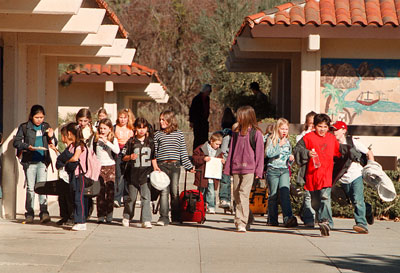Taking a cue from Mr. Rogers, county elementary school officials
ask students to
”
be their neighbors.
”
Known as neighborhood schools, district students are enrolled at
campuses close to their homes, in part to provide for a sense of
community.
Taking a cue from Mr. Rogers, county elementary school officials ask students to “be their neighbors.”
Known as neighborhood schools, district students are enrolled at campuses close to their homes, in part to provide for a sense of community.
“Parents prefer (neighborhood schools) because it’s close,” said Jackie Munoz, superintendent of the Aromas-San Juan Unified School District. “There’s a sense of ownership when you go to a school in your neighborhood. Your friends are close by.”
Though enrolling students in neighborhood schools can be automatic, parents can request that their child attend a school outside their area.
“We have an open enrollment policy. Parents can apply to have their kids go somewhere else, but we don’t get an overwhelming amount of requests,” said Judith Barranti, superintendent of the Hollister School District.
Barranti said one of the reasons parents want their children attending schools outside their area is day care issues.
Parents can also request a school change at ASJUSD, but the large geographical area of the district makes requests rare.
“It’s different for us because we are rural (and) transportation is an issue,” she said.
Spring Grove School is one school in the county that enrolls a number of students outside its district. District Superintendent Tom Guajardo said 20 percent of the school’s 530 students come from other school districts.
“It’s a nice problem,” he said. “It says a lot for our school.”
Spring Grove has some students from Hollister, and even Gilroy, Guajardo said. Students who come from other districts are not eligible for district-provided transportation.
Guajardo said the smaller size of the school is what attracts so many students from outside the area.
“This is a place where kids receive a lot of attention – academic and personal,” he said.
The HSD attempts to keep its eight schools balanced, size-wise, Barranti said. When students attend a nearby school, there is less of a need to provide busing, which helps reduce costs for the district. Even though this is beneficial, Barranti said it was not the priority.
“(Neighborhood schools) give people who live in the same geographical area a sense of community,” she said.
Neighborhood schools also allow parents to be involved in the community through the school and its students, Barranti and Munoz said.
Also, not attending schools in a student’s neighborhood leads to a decrease in the number of youths walking or bicycling to school.
In August, the Centers for Disease Control and Prevention released results of a national survey that looked at why children were not walking to school. The survey, conducted in 1999, found that only a quarter of American children walk or bicycle to school, which may be contributing to the country’s increasing problem of childhood obesity. In 1999, 13 percent of children and teen-agers were overweight, according to the CDC.
The top concerns for parents were distance, traffic, weather and crime, according to the survey.










